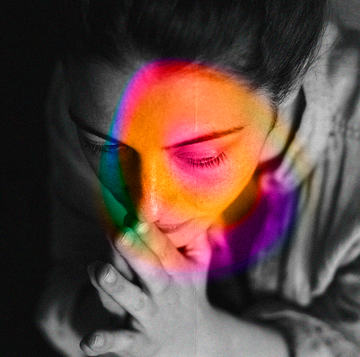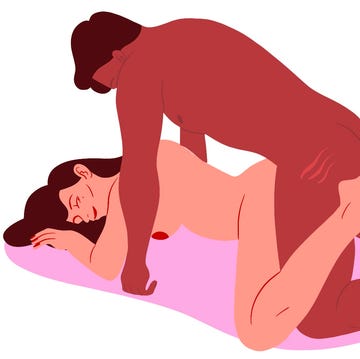For Gen Z, gone are the days of spending hours in the bathroom getting ready for a first date. According to Tinder’s 2023 Future of Dating report, around 51 percent of global Tinder users ages 18 to 25 are making dating a low-pressure part of their regular, daily lives. Whether they’re sneaking in dates after a morning exercise class or meeting up before dinner with friends, fitting in dates whenever works for them is what Paul Brunson, Tinder’s Global Relationship Insights Expert, calls “stack dating” or “errand dating.” And while associating a date with an “errand” might not sound the most romantic, that's kind of the point. (Hear me out!)
Basically, young singles are slotting in dates along with what's already on their plates for the day—just like they would when meeting up with a friend, booking a workout class, or getting work done. They've realized that while, yes, dating is important, it doesn't have to be A Whole Thing™, and find that when they treat dating like just another thing on their schedule, they're able to show up as more authentic versions of themselves. In fact, 32 percent of Gen Z Tinder users are even meeting up for dates during the work day. Coffee break, anyone? 👀
According to Brunson, some Gen Z-ers are making dating work for them by going on several short dates in a row (kind of like modern-day speed dating), if it fits into their schedule, which he says is “important and empowering.” Why? Because it’s a proactive (not reactive) way to date.
“Most of us sit back and wait for someone to choose us. But with stack dating, what you’re saying is, ‘I have a limited amount of time in my schedule. I will proactively put the people I’m dating into a specific moment of my day or week,’” Brunson explains. And when you’re interacting with romantic prospects more often, you’ll likely be more confident and sure of who you’ll be compatible with long-term.
That said, just because stack dating is “in," doesn’t mean it's a fit for everyone. There’s more to unpack when it comes to Gen Z’s new favorite dating technique, according to actual Gen Z folks and certified relationship experts.
Wait, So, What's the Difference Between Stack Dating and Regular Dating?
Stack dating—also called errand dating—is when you’re fitting in dates among other activities in your daily schedule, whether it’s during work hours, a breakfast date, or meeting up in the park on your way to hang with friends. It’s a dating technique employed by Gen Z folks who want to prioritize dating by making it work within whatever time they have, but who also don't want to prioritize it too much by making it a huge deal, Brunson explains. Sometimes, it can even mean having multiple dates in a row when you have the time for it.
It’s also a way to put less pressure on dating by nixing prep time (like getting super dolled up or planning a whole night out) and all the anxiety that comes with it for short, easy-going dates that let you show up as your most authentic self. TL,DR: You get to prioritize making romantic connections without “wasting your time” or putting all of your eggs in one basket, explains AASECT-certified sex therapist Janet Brito, PhD, founder of the Hawaii Center for Sexual and Relationship Health.
And while, yes, regular dating also involves finding time for your date just like stack dating, it also often involves tons of prep work, giving up a long block of your day or night to meet up with someone for the first time, not knowing whether or not it will be worth it, and all the anxiety that comes with making a first date a whole production. Stack dating takes all of that away by positioning dating as just another part of your regular 'ol day.
What Are Some Pros to Stack Dating?
The best part of stack dating is its emphasis on keeping things real, Brunson says, so it makes sense it would be popular among Gen Z—50 percent of those surveyed in the Future of Dating report are prioritizing a romantic interests’ authenticity over all else. In fact, the report found that Gen Z is the first generation that does not [rank] physical attraction as the number one most important factor when it comes to romantic interest, says Brunson. “Instead, they’re asking: Do I feel comfortable being myself in front of this person?”
Think about it: When you’re meeting someone during work hours (in their work clothes) or grabbing coffee after the gym, it feels like you’re experiencing a regular part of their day, which, if you end up dating, is probably the version of them you're going to get most of the time. “My personality is simply not going to change for somebody on a quick date,” explains Kathleen, 24, a Gen Z dater. “There’s too many fish in the sea to act like somebody I’m not,” she says.
And if you’re not feeling it, stack dating gives you a hard “out” for when you want to end the date. “You’re kind of on the clock,” explains Talia, 21. “It’s easier to end a date when you have a strict 30-minute time limit or plans afterward as an excuse,” she says—even if it (unfortunately) means you have to head back to work or class. Safety-wise, this is also smart. Having somewhere to be after the date means that if you’re in danger, odds are your lateness will signal something is up, quickly.
That said, be mindful of how you verbalize any time constraints when you meet up with your date. Perhaps don't lead with the fact that you have plans post-date, especially if it's to meet up with another potential romantic interest! Remember: Just because you're stack dating, doesn't mean you should make someone feel like they're not important to you. Give your date your full attention by putting your phone away, asking questions about their life and interests, and if you're feeling it, don't be afraid to flirt and extend the date past your initial time.
Another benefit to stack dating? It keeps the stakes low. “If you go about dating casually and the connection doesn’t go anywhere, you won’t be as disappointed as if you had invested tons of time and energy into a person,” Brito explains. You’ll be better able to discern who you're compatible with, too, since you can more clearly compare how dates went when you're experiencing them one after another, Brunson says. He suggests asking yourself: Which date was curious? Who listened to me most? Which date was purely physical attraction versus genuine interest?
Are There Any Cons to Stack Dating?
For starters, some Gen Z folks think the low-pressure convenience of stack dating doesn’t add up. “To be honest, I prefer to have an actual break during my lunch or downtime,” explains Elizabeth, 24. “I don’t want to feel rushed on a date, and I prefer to keep my leisure time leisurely, which means not talking to a man I don’t know,” she explains.
And while having multiple dates in a row allows you to run what Brunson calls a “comparative study” of how each date went, he also says that, of course, having too many options can lead to the classic paradox of choice. “If you’re someone who struggles making decisions, having to choose between pursuing eight different dates you’ve had can be difficult,” Brunson says. Basically, having too many options can make a low-pressure situation stressful for some, and can even be exhausting, Brito says. (Which defeats the whole purpose.)
There’s also the risk of seeming like you don’t care about the date, even if you do. Time constraints or squeezing dates in on lunch breaks “might feel unromantic to some people,” Brito says. “It can signal that you don’t really care about making the date feel special or getting to know the person,” she says, which can read as insensitive.
So, How Can You Actually Make Stack Dating Work For You?
For starters, make sure it doesn’t feel like an errand to the person you’re with. “It’s easy to tell if someone is treating a date like an interview,” says Molly, 20. Have respect for your date and make an effort to show them you care. Remember that while stack dating means you're putting less pressure on the date, it doesn't mean you shouldn't take the interaction seriously and give 100 percent of your energy while you're there.
And perhaps the best way to make stack dating work for you is to just keep it 100 percent real. Because stack dating is all about making dates work for your lifestyle, this means you have to show up as you on the dates—not some idealized version of you, or who you think your date wants you to be. “If a date is not genuine, it can be an ick,” Molly says. Sure, not everyone is going to love you for who you are, but that’s kind of the point of stack dating: to weed out the wrong matches.
“Gen Z has basically said, ‘I'm going to show up as me. And if you can accept me as I am, then that in itself means we’re compatible,'” Brunson explains.
Ready to start planning those dates? Cool. Per the Future of Dating report, most users schedule a date with a crush within a few days of messaging on the app. So if you’ve been feeling a couple people, don’t be afraid to start talking about meet-up logistics.
Perhaps you’re free on your next lunch break?
Madeline Howard is a writer, editor, and creative based in Brooklyn. Her work has been published in Esquire, Nylon, Cosmopolitan, and other publications. Among other things, she was formerly an editor at Women’s Health. Subscribe to her newsletter ‘hey howie’ at madelinehoward.substack.com.













